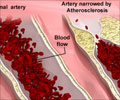
Conversely, they found that reductions of fine particulate air pollution over time were linked to slower progression of the blood vessel thickness.
Their research is published in this week's PLOS Medicine.
The thickness of this blood vessel is an indicator of how much atherosclerosis is present in the arteries throughout the body, even among people with no obvious symptoms of heart disease.
"Our findings help us to understand how it is that exposures to air pollution may cause the increases in heart attacks and strokes observed by other studies," Adar said.
The researchers followed 5,362 people ages 45-84 from six U.S. metropolitan areas as part of the Multi-Ethnic Study of Atherosclerosis and Air Pollution (MESA Air). The researchers were able to link air pollution levels estimated at each person's house with two ultrasound measurements of the blood vessels, separated by about three years.
Advertisement
"Linking these findings with other results from the same population suggests that persons living in a more polluted part of town may have a 2 percent higher risk of stroke as compared to people in a less polluted part of the same metropolitan area," Adar said.
Advertisement
Source-Eurekalert












